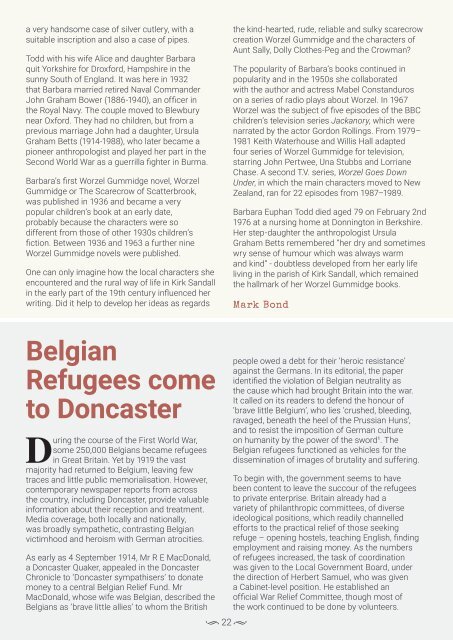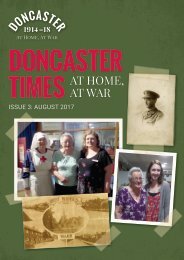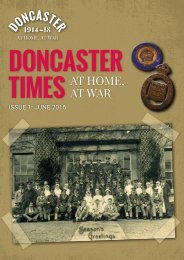Doncaster Times Issue 2 - November 2016
Doncaster Times is a biannual publication of articles and pieces researched and written by members of the public, volunteers and professionals. For its first four years, the magazine will feature articles about Doncaster during the First World War, to commemorate the centenary. The most recent publication is available in hard copy only, available to purchase from Doncaster Museum and Art Gallery, Doncaster Central Library and the Tourist Information Centre.
Doncaster Times is a biannual publication of articles and pieces researched and written by members of the public, volunteers and professionals. For its first four years, the magazine will feature articles about Doncaster during the First World War, to commemorate the centenary. The most recent publication is available in hard copy only, available to purchase from Doncaster Museum and Art Gallery, Doncaster Central Library and the Tourist Information Centre.
You also want an ePaper? Increase the reach of your titles
YUMPU automatically turns print PDFs into web optimized ePapers that Google loves.
a very handsome case of silver cutlery, with a<br />
suitable inscription and also a case of pipes.<br />
Todd with his wife Alice and daughter Barbara<br />
quit Yorkshire for Droxford, Hampshire in the<br />
sunny South of England. It was here in 1932<br />
that Barbara married retired Naval Commander<br />
John Graham Bower (1886-1940), an officer in<br />
the Royal Navy. The couple moved to Blewbury<br />
near Oxford. They had no children, but from a<br />
previous marriage John had a daughter, Ursula<br />
Graham Betts (1914-1988), who later became a<br />
pioneer anthropologist and played her part in the<br />
Second World War as a guerrilla fighter in Burma.<br />
Barbara’s first Worzel Gummidge novel, Worzel<br />
Gummidge or The Scarecrow of Scatterbrook,<br />
was published in 1936 and became a very<br />
popular children’s book at an early date,<br />
probably because the characters were so<br />
different from those of other 1930s children’s<br />
fiction. Between 1936 and 1963 a further nine<br />
Worzel Gummidge novels were published.<br />
One can only imagine how the local characters she<br />
encountered and the rural way of life in Kirk Sandall<br />
in the early part of the 19th century influenced her<br />
writing. Did it help to develop her ideas as regards<br />
the kind-hearted, rude, reliable and sulky scarecrow<br />
creation Worzel Gummidge and the characters of<br />
Aunt Sally, Dolly Clothes-Peg and the Crowman?<br />
The popularity of Barbara’s books continued in<br />
popularity and in the 1950s she collaborated<br />
with the author and actress Mabel Constanduros<br />
on a series of radio plays about Worzel. In 1967<br />
Worzel was the subject of five episodes of the BBC<br />
children’s television series Jackanory, which were<br />
narrated by the actor Gordon Rollings. From 1979–<br />
1981 Keith Waterhouse and Willis Hall adapted<br />
four series of Worzel Gummidge for television,<br />
starring John Pertwee, Una Stubbs and Lorriane<br />
Chase. A second T.V. series, Worzel Goes Down<br />
Under, in which the main characters moved to New<br />
Zealand, ran for 22 episodes from 1987–1989.<br />
Barbara Euphan Todd died aged 79 on February 2nd<br />
1976 at a nursing home at Donnington in Berkshire.<br />
Her step-daughter the anthropologist Ursula<br />
Graham Betts remembered “her dry and sometimes<br />
wry sense of humour which was always warm<br />
and kind” - doubtless developed from her early life<br />
living in the parish of Kirk Sandall, which remained<br />
the hallmark of her Worzel Gummidge books.<br />
Mark Bond<br />
Belgian<br />
Refugees come<br />
to <strong>Doncaster</strong><br />
During the course of the First World War,<br />
some 250,000 Belgians became refugees<br />
in Great Britain. Yet by 1919 the vast<br />
majority had returned to Belgium, leaving few<br />
traces and little public memorialisation. However,<br />
contemporary newspaper reports from across<br />
the country, including <strong>Doncaster</strong>, provide valuable<br />
information about their reception and treatment.<br />
Media coverage, both locally and nationally,<br />
was broadly sympathetic, contrasting Belgian<br />
victimhood and heroism with German atrocities.<br />
As early as 4 September 1914, Mr R E MacDonald,<br />
a <strong>Doncaster</strong> Quaker, appealed in the <strong>Doncaster</strong><br />
Chronicle to ‘<strong>Doncaster</strong> sympathisers’ to donate<br />
money to a central Belgian Relief Fund. Mr<br />
MacDonald, whose wife was Belgian, described the<br />
Belgians as ‘brave little allies’ to whom the British<br />
•<br />
22 •<br />
people owed a debt for their ‘heroic resistance’<br />
against the Germans. In its editorial, the paper<br />
identified the violation of Belgian neutrality as<br />
the cause which had brought Britain into the war.<br />
It called on its readers to defend the honour of<br />
‘brave little Belgium’, who lies ‘crushed, bleeding,<br />
ravaged, beneath the heel of the Prussian Huns’,<br />
and to resist the imposition of German culture<br />
on humanity by the power of the sword 1 . The<br />
Belgian refugees functioned as vehicles for the<br />
dissemination of images of brutality and suffering.<br />
To begin with, the government seems to have<br />
been content to leave the succour of the refugees<br />
to private enterprise. Britain already had a<br />
variety of philanthropic committees, of diverse<br />
ideological positions, which readily channelled<br />
efforts to the practical relief of those seeking<br />
refuge – opening hostels, teaching English, finding<br />
employment and raising money. As the numbers<br />
of refugees increased, the task of coordination<br />
was given to the Local Government Board, under<br />
the direction of Herbert Samuel, who was given<br />
a Cabinet-level position. He established an<br />
official War Relief Committee, though most of<br />
the work continued to be done by volunteers.




